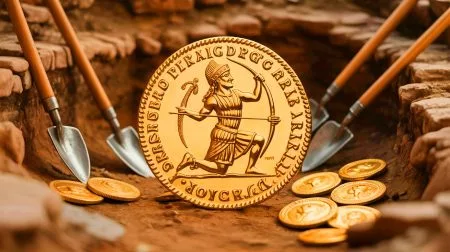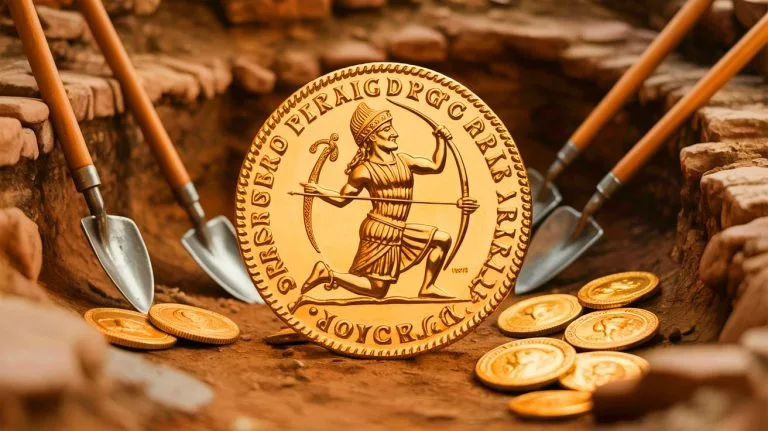| IN A NUTSHELL |
|
In a groundbreaking archaeological discovery, researchers have uncovered a Persian gold hoard in Turkey, a find that has the potential to reshape our understanding of ancient military and economic history. The coins, unearthed from the ruins of a Hellenistic house in western Turkey, may have served as payments for mercenaries during the tumultuous conflicts between Athens and Persia. This discovery, made by a team from the University of Michigan, highlights a critical aspect of ancient military and economic infrastructure. The coins, known as darics, are among the rarest gold hoards ever found in a controlled excavation and could provide valuable insights into the financial mechanisms of ancient empires.
A Cache of Coins in the Crossfire of Empires
The Persian gold hoard was discovered in a small pot beneath layers of stone in Notion, an ancient coastal city in what is now Turkey. These coins, minted in the fifth century B.C., bear the image of a kneeling archer, a hallmark of the Persian daric. Likely struck in the ancient city of Sardis, located approximately 60 miles from the find site, these coins were unearthed in a region often at the center of Persian-Greek conflict. Their strategic location and timing suggest they were not mere lost treasures but were intended as war payments to fund mercenary forces during a volatile period characterized by occupation and rebellion.
Christopher Ratte, director of the Notion Archaeological Survey, remarked on the rarity of such a find, emphasizing that no one buries valuable coins without the intent to retrieve them. The fact that these coins were preserved suggests misfortune, possibly linked to a lost battle or the sudden demise of the person tasked with their safekeeping. This misfortune has become a boon for archaeologists, providing a window into the economic strategies employed by ancient empires during periods of conflict.
Mercenaries, Misfortune, and a Timeline Anchored in Gold
The coins are thought to represent a payment cache for foreign mercenaries, a common practice in the late Classical period when states like Athens and Persia increasingly relied on non-native fighters. Ancient historian Xenophon notes that one daric was equivalent to a month’s pay for a soldier, indicating that the hoard could have supported a small contingent of professional warriors. This underscores the pivotal role financial resources played in shaping battlefield tactics in regions like Notion, where control frequently shifted between Persian and Greek hands before ultimately falling to Alexander the Great in 334 B.C.
Beyond their implications for military logistics, the coins provide a firm chronological anchor, offering numismatists a rare opportunity to calibrate the production timeline of Achaemenid gold coinage. The coins’ preservation in a sealed archaeological context, coupled with proximity to other artifacts, allows researchers to more accurately determine the age and circulation range of the darics, enhancing our understanding of ancient economic systems.
Chronology, Coinage, and the Achaemenid Footprint
This discovery is particularly timely for scholars reevaluating the economic machinery of the Achaemenid Empire. Gold darics were widely circulated across the empire, but their dating has been challenging due to their uniform design and lack of inscriptions. The newly discovered hoard allows researchers to isolate specific stylistic shifts and refine the monetary timeline during the rule of Darius I and his successors.
Andrew Meadows, a numismatics expert, underscores the importance of this find, stating that if the dating can be accurately established, it could significantly impact our understanding of Achaemenid gold coinage. This discovery may resolve longstanding debates in Persian numismatics and illuminate how imperial economies functioned under military duress, providing a clearer picture of the economic underpinnings of ancient empires.
A Pot of Gold That Redraws the Past
The University of Michigan’s announcement emphasizes how this hoard represents a snapshot in time and a broader narrative of ancient geopolitical tensions. Notion, once a minor city along the Aegean coast, now emerges as a crucial node in Persian logistics, a frontline not only of war but of imperial financial planning. Ongoing analysis, including metallurgical studies and 3D modeling, promises to further illuminate the role of the site in reconstructing fifth-century B.C. military financing.
This “pot of gold,” preserved against the odds, transcends its status as mere treasure. It serves as a historical document, revealing the movement of gold with armies, the financial strategies of empires, and how a lost paymaster’s misfortune became an invaluable gain for archaeology.
This remarkable discovery opens new avenues for understanding ancient economic and military systems. As researchers continue to analyze the hoard, questions remain about the broader implications of such findings. How might this discovery influence our perception of Persian influence in the Mediterranean region, and what other hidden treasures might await discovery beneath the sands of history?
Did you like it? 4.5/5 (27)






Wow, this is like finding a pirate’s treasure chest! 🏴☠️
Wow, this is amazing! How much gold are we talking about here? 🪙✨
I’m curious, how do they know the coins were meant for mercenaries?